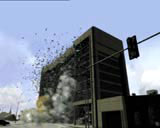The law of gravity
Why Buildings Fall Down is a series documenting architectural catastrophes and ways they could have been avoided. Matthew Valentine sees how it stands up

In an age when, in the Western World, we are probably safer than ever before, we seem to spend more and more time worrying about danger. We don’t get conscripted into the armed forces and we don’t generally die of ‘flu anymore. So we worry about other, rarer things, such as BSE or serial killers.
Modern fears like these tend to be ones where individuals are unable to hold much, if any, responsibility for their own safety, hence the levels of stress. And, the Paddington rail crash providing a good example, the anger. Why, people ask, are we placed in unnecessary danger by faceless bureaucrats or corporations?
Those of a worrying nature might save themselves a lot of trouble by not watching Why Buildings Fall Down, a new Channel Four series. Detailing a number of fatal building collapses, it looks at how design and technology could have prevented huge loss of life.
The advances in building safety are impressive, and grow, tragically, with each new disaster as we continue to learn by our mistakes. What will really ignite worriers, and conspiracy theorists, are the cases where deaths were caused by penny-pinching or sheer stupidity on behalf of the developers.
In 1968 the Ronan Point tower block in London collapsed three weeks after its occupants had moved in, miraculously killing only four people. It happened at 5.45am, as Ivy Hodge tried to light a gas ring to boil her kettle. A leak in the incorrectly fitted gas pipe caused an explosion and 22 floors of the building collapsed along a whole corner of the structure.
Ronan Point was of a type of building supposed to solve the UK’s social housing problems. It was made using a large panel, pre-fabricated system, allowing quick and easy construction. It had proved useful and safe in Denmark, where it was developed. The Danes, however, never used the system for buildings more than six floors high. Neither do they use gas in their homes. A massive project of strengthening or demolition had to be carried out on similar UK buildings. Amazingly, Ivy Hodge was among the survivors.
If the US is to continue its policy of encouraging citizens to walk around armed to the teeth it had better look at its building regulations, too.
When the Alfred P Murrah building in Oklahoma was bombed by All American Militias, 168 people were killed, 19 of them children in the cr̻che. The bombers employed 2300kg of homemade explosive Рa powerful device, but, on the face of it, not powerful enough to wreak the carnage it did.
Investigations have since shown that the design of the building, which featured wide-spaced columns topped by one massive transfer girder, contributed to the damage. The girder was tipped backwards by 90 degrees as the combined force of the bomb blast and collapsing pillars hit it. It pulled the rest of the building down. An impressive computer animation, created by Red Vision, illustrates the effect.
“You see this a lot in American architecture,” viewers are told of the building’s design – a fact which is unlikely to calm the third floor manager from the federal building, who lost 18 of her 33 staff in the blast.
Unlike the victims of bombs and local authorities, those faced with earthquakes often have nobody to point the finger of blame at. Incidents in San Francisco and Kobe in Japan, where 5000 people died in 1995, form the major case studies here, including the X Files-worthy phenomena of liquefaction. This is where the soil molecules are so tightly compressed that the ground effectively turns into water.
Survivors of recent earthquakes in Turkey have every right to get angry though. An earthquake hotspot, the country copied its building regulations from California to ensure safety regulations were as stringent as possible. Nobody enforced the rules.
Why Buildings Fall Down is scheduled to begin at 8pm on Channel Four, 10 January.
-
Post a comment



